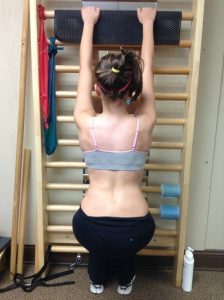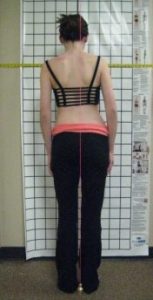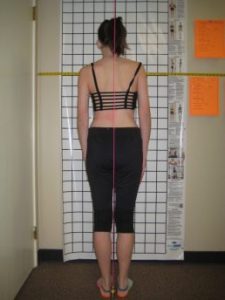Schroth Method Exercises (Schroth Physiotherapy)
Written and reviewed for scientific and factual accuracy by Dr. Austin Jelcick, PhD and Dr. Matthew Janzen, DC. Last reviewed/edited on October 26, 2020. First published January 18, 2018.
What is Schroth Physiotherapy?
The Schroth physical therapy method (aka Schroth physiotherapy) incorporates exercises to strengthen weak muscles and lengthen shortened muscles while breathing into the concavities of the curve. Meanwhile, during these exercises, correction of the pelvis, ribs, and shoulder alignment is emphasized. Schroth physiotherapy addresses the spinal rotation by corrections in all three planes. Since the spine has shortened due to the rotation and curves, the spine needs to elongate. This is why the Schroth based method is called a “three-dimensional treatment for scoliosis.” Furthermore, these exercises not only assist the brain and body with recognizing proper alignment of the spine but also in maintaining this alignment. For the body to respond and hold the proper posture, these exercises are to be performed daily!
Who can benefit from Schroth based physiotherapy?
Schroth Based Scoliosis Exercises
Schroth Physiotherapy (and thus Schroth-based exercises) use deep breathing to expand the rib cage, open the concavities of the curves, and re-align the body into center. During the exercises, an individual is taught where to concentrate and connect the mind to the body to maintain alignment. These exercises begin in positions where gravity is eliminated from compressing the spine, and eventually transition to upright positions that do affect the spine. These positions assist in strengthening and stabilizing the spine for normal movement and activities.
Conscious Positional Awareness (aka-activity modification) is key.
Poor posture while playing sports or while stagnant (slouching) can destroy everything the scoliosis patient is working towards. This does not mean that the patient needs to stop enjoying their favorite activities. However it is crucial that they are conscious of their posture and making an active effort to avoid positions that can worsen their curve.
Our ULTIMATE goal for all of our patients is a healthy, happy, normal life.
We want our patients to continue doing what they love to do. Take that away from them and the quality of their life didn’t get better for them…it got worse. Every now and then, we do need to cut an activity out because continuation of that activity has no modified and improved posture and would significantly hurt the improvement of the patient. Activity modification (conscious positional awareness) helps ALL the other treatments have more effectiveness and prevents the collapse of the spine the other 16 hours of the day that they aren’t doing their other, more aggressive Scoliosis Exercises. This is all a conscious effort throughout the day that has to eventually become a “Good Habit” that the patient can use for the rest of their life. Our “Schroth-based” training program focuses on the patient’s activities and teaches them how to do what they love to do, with better posture.
- Anyone with scoliosis
- Post scoliosis fusion
- Juveniles
- Teenagers
- Adults with painful degenerative scoliosis
- Post menopausal women
Interested in learning more about why Schroth works?
Check out this article:
“The efficacy of three-dimensional Schroth exercises in adolescent idiopathic scoliosis: A randomized controlled clinical trial”
The Schroth Method is Called a “Three-Dimensional Treatment for Scoliosis”
The Schroth-based exercises have many benefits for the adolescent, adult, and even the post-fusion patient. The literature continues to grow in support of the Schroth method. Studies show that these exercises can stop progression of curves in adolescents, potentially reduce the abnormal curves, reduce pain, increase lung capacity, and avoid surgery.
Other effects of Schroth Therapy include improved:
- Posture
- Torso deformity
- Mental status
If you have had spinal fusion for scoliosis, attention to your posture, body mechanics, strength of your musculature, stability of the segments above and below the fusion, and lung capacity should be managed.
What are the long term results of Schroth-based therapy?
- Improve body appearance by postural corrections
- Improve lung capacity and rib mobility with deep breathing
- Improve posture in sitting, standing, walking, and activities throughout the day
- Learn proper body mechanics to protect your spine throughout the day
- Assist in opening the concavities of the spine
- Instruct in strengthening exercises for specific muscles to assist in supporting spine in a balanced alignment
- Improve understanding of your scoliosis
- Prevent, decrease, or assist in pain management associated with scoliosis
- Improve body awareness and conscious control of your position and posture
- Connect the mind to the body and re-educate muscles to do their job
When learning these exercises to manage scoliosis, the patient will continue practicing at home. These principles will then be applied during activities of daily living.
Each individual will understand their curve pattern and how gravity, positions, and activities will affect their curve. For example, someone with a left thoraco-lumbar curve should not be sitting with all their weight on their left side of their pelvis. They will also learn not to stand with all their weight on their left.
These exercises and principles applied to daily life will assist the individual in managing their scoliosis throughout life. Their body awareness in space with sitting, standing, and moving is increased during the training time. Therefore, they will be more aware of how they are sitting at school, at the office, in the car, at the dining room table, while watching television, or on the computer.



